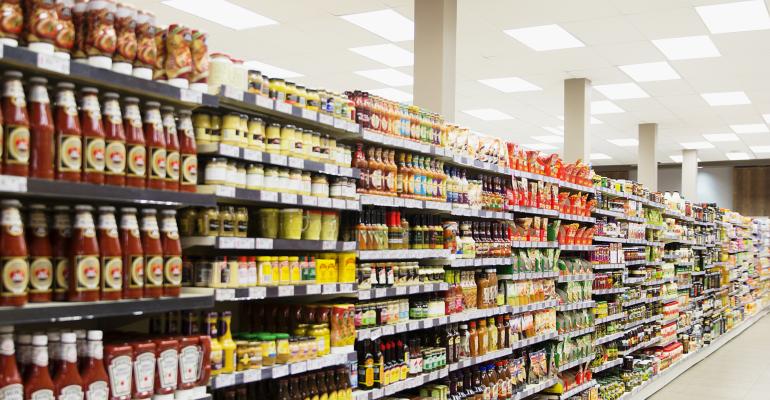Sharp price increases and the resulting changes in consumer behavior have impacted sales across center store categories throughout the past year.
The two largest center store categories in terms of sales — salty snacks, and carbonated beverages — both experienced double-digit gains in dollar sales for the 52 weeks ending May 21, according to Circana sales data. Unit sales for both of these high-volume categories were down for the year, however. Salty snack dollar sales were up 15.6% across all outlets, while unit sales were down 0.6%, compared with a year ago, while carbonated beverages saw dollar sales rise 14.9% and unit sales fall 2.9%.
Other top-selling center store categories that have followed similar sales patterns include bottled water, both chocolate and non-chocolate candy, sports drinks, soup, frozen pizza, and pet food. A handful of the largest categories, such as energy drinks, Mexican foods, pasta, rice, and upper respiratory medications, have seen gains in both dollar sales and unit volume, reflecting a combination of price increases and changes in consumer behavior.
Among the fastest-growing center store items in terms of dollar sales in this year’s Circana data were water filters, as consumers increasingly seek to remove contaminants from their tap water and at the same time transition from single-use plastic bottles to reusable containers. Premixed cocktails and coolers also showed strong growth in both dollars and units, and consumers have taken an interest in the convenience, quality, and increasing variety of these items.
Other categories that saw the sharpest increases in dollar sales appeared to have been driven by price increases, such as evaporated/condensed milk. Dollar sales were up 25.7%, driven by a similarly high rate of price-per-unit inflation of 28.1%. Flour and meal followed a similar pattern, with dollar sales up 22.8% and the price-per-unit up 24.6%.
Consumers have engaged in a variety of tactics to ease the impact of inflation, including both trading down to smaller, more affordable pack sizes, and in some cases buying larger pack sizes to save money over the long term.
“In general, within food and beverage and also in other categories outside of food, we have seen a ‘trade down’ mentality to fight higher prices,” said Sally Lyons Wyatt, executive VP and practice leader at Circana.
Consumers are often either opting for smaller pack sizes with their favorite brands, or switching to private brand alternatives, she said.
“In some instances, they have just walked away from categories because they cannot afford them at any price,” she said.
Consumers may also be spreading their grocery shopping out among different retailers to find the best prices, Lyons Wyatt said. In addition, as some consumers have returned to working in offices and resumed their previous commuting routines, they may be sourcing more meals from quick-service restaurants and convenience stores instead of making them at home, reducing their need for some grocery items.
Tabitha Sewell, director of category management at KeHE Distributors, agreed that consumers are taking a variety of actions to save money on groceries.
“Consumers are comparing prices, shopping in-store flyers, and buying what is on promotion more than ever due to the pain of inflation,” she said.
John Bierfeldt, executive VP of client development at Acosta, said that even though inflation on some products has eased, consumers may still be shopping more cautiously. Acosta’s consumer research has found that about a third of consumers believe the economy is currently in recession, and another 38% believe that a recession is coming soon.
“Economic uncertainty and inflation continue to take a toll on shoppers,” he said, noting that consumers are sticking with their recessionary behaviors.
Only 10% of shoppers in Acosta’s research said they have noticed lower prices on groceries in recent weeks.
Acosta’s research shows that consumers shopping for value are making intentional decisions in three primary areas, Bierfeldt said:
- Brand shifting to private label: 40% of shoppers are buying more private label products to save money when shopping for groceries
- Channel shifting: According to Acosta Group Shopper Insights, 39% of consumers are shopping at discount grocery stores like Aldi, and 36% are buying groceries and household needs at dollar stores. Sales at value retailers, including Walmart, jumped 6% in May compared to the previous year, capturing 42.3% of CPG sales, with food as the primary driver of share gains, Bierfeldt said, citing data from NIQ
- Shopping on promotion: Promotional sales, up 11% in May, remain a growth driver, accounting for 26.6% of CPG sales, according to NIQ, Bierfeldt said.
Acosta’s research finds that 84% of shoppers are searching for deals all or most of the time when shopping for groceries.
Retailers are pursuing a number of tactics to keep prices affordable for consumers, including working to win the big holidays, Bierfeldt said. Aldi reduced pricing by 30% for July 4, for example. Another example is bundling products for families, as Kroger is doing with its meal promotion targeted for families with children home from school for summer break.
In its recently published CPG Confidential and Retailer Confidential survey, Acosta found that six out of 10 agree that promotional frequency over depth in this environment is the right strategy, in addition to looking at everyday low pricing.





